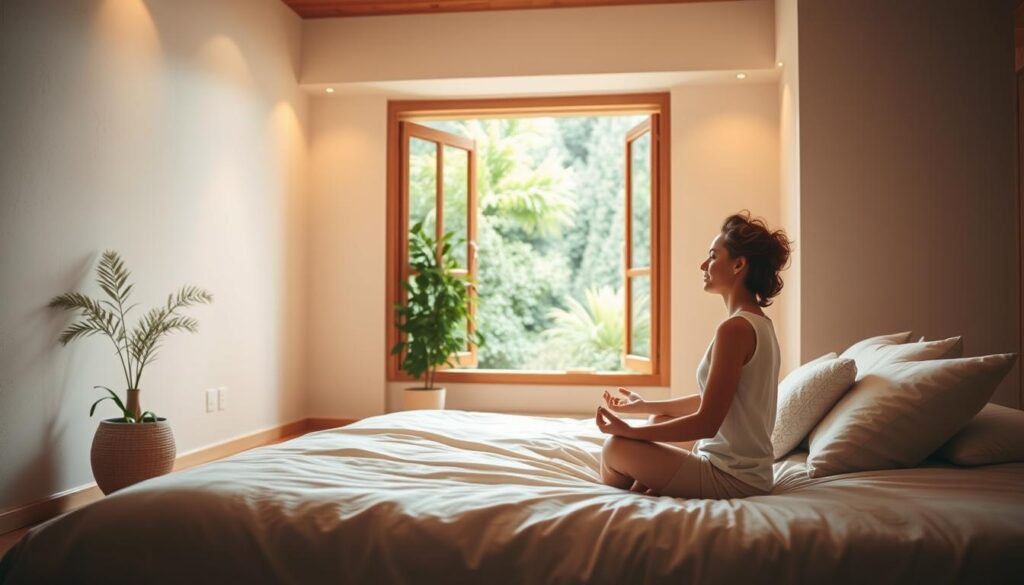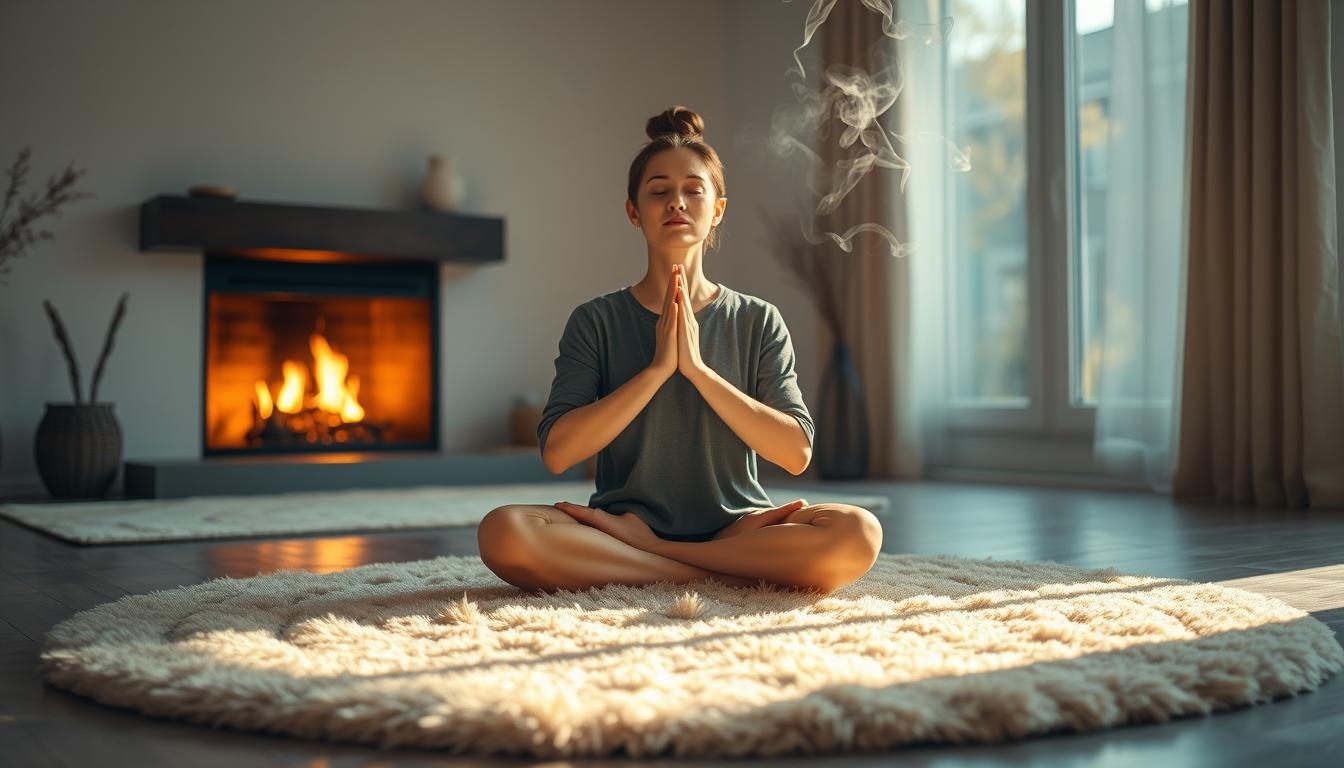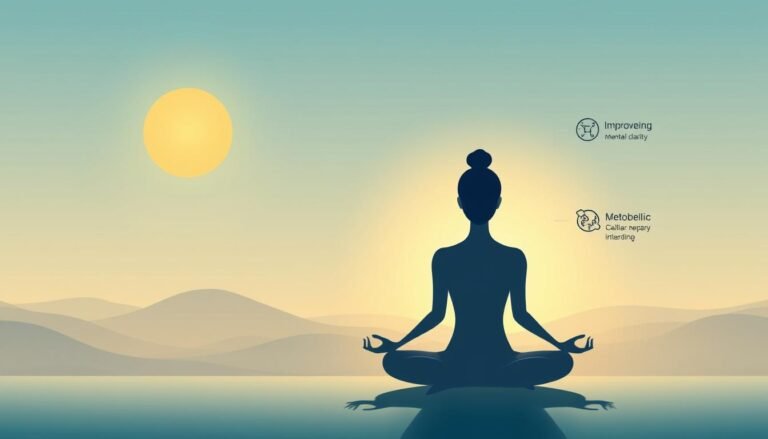Are you always fighting stress that takes over your day? What if you could find easy ways to calm your mind and body?
In today’s world, stress is a common problem. It can make you tired, hurt your health, and lower your happiness. Finding ways to manage stress is key to feeling good.
This guide shows you simple ways to relax. You’ll learn how to reduce stress and find peace. These tips work for anyone, no matter how busy you are.
Key Takeaways
- Stress impacts both mental and physical health
- Simple techniques can effectively manage anxiety
- Mental wellness is achievable through targeted strategies
- Everyone can learn stress reduction methods
- Consistent practice leads to meaningful results
Understanding the Impact of Stress on Mind and Body
Stress is a complex phenomenon that can dramatically affect your mental health and emotional balance. Your body responds to stressful situations through a intricate series of physiological and psychological reactions. These reactions impact every aspect of your well-being.

When you experience chronic stress, your body goes into a constant state of alert. This ongoing tension can trigger a range of challenging symptoms. These symptoms disrupt your healthy mind and overall quality of life.
Physical Symptoms of Chronic Stress
Stress management begins with recognizing how stress manifests physically. Your body may signal ongoing stress through:
- Persistent headaches
- Muscle tension and pain
- Digestive system disruptions
- Weakened immune response
- Irregular sleep patterns
Mental and Emotional Effects of Stress
Coping with stress requires understanding its mental impact. Psychological symptoms can include:
- Increased anxiety
- Mood swings
- Difficulty concentrating
- Reduced decision-making capabilities
- Emotional exhaustion
The Science Behind Stress Response
Your body’s stress response is rooted in a primitive survival mechanism. When threatened, your brain triggers a complex hormonal cascade, releasing cortisol and adrenaline. These hormones prepare you for potential danger. While this response was crucial for our ancestors, modern stressors require different coping strategies.
Understanding your stress response is the first step toward effective stress management and mental wellness.
Quick Breathing Exercises for Immediate Calm

Stress can hit you out of nowhere, making you feel overwhelmed and anxious. Breathing techniques are a quick and effective way to calm down and manage your anxiety. They can be your go-to in tough situations.
Deep breathing exercises are simple yet very effective for handling anxiety. They trigger your body’s natural relaxation response, helping you take back control when you’re stressed.
- Diaphragmatic Breathing: Put one hand on your chest and the other on your stomach. Breathe deeply through your nose, making sure your stomach goes up more than your chest.
- Box Breathing: Breathe in for 4 seconds, hold for 4 seconds, breathe out for 4 seconds, and pause for 4 seconds. Do this 4-5 times.
- 4-7-8 Technique: Breathe in for 4 seconds, hold for 7 seconds, breathe out for 8 seconds. This resets your nervous system.
Try these breathing exercises anywhere – at work, in traffic, or before a big meeting. With regular practice, you’ll have a strong tool for quick stress relief and emotional balance.
“Breath is the bridge between mind and body.” – Thich Nhat Hanh
Mindfulness Meditation: Your Gateway to Inner Peace
Meditation is a powerful way to reduce stress and find peace. By practicing mindfulness meditation, you can change your mind and handle daily stress better. This ancient practice helps you stay calm inside, even when things outside are tough.
Mindfulness meditation isn’t about clearing your mind. It’s about being aware of what’s happening right now. It’s a soft way to deal with anxiety and find emotional balance.
Getting Started with Basic Meditation
Here’s how to start your meditation journey:
- Find a quiet, comfy spot
- Sit in a relaxed way
- Focus on your natural breathing
- Watch your thoughts without judging
- Start with 5-10 minute sessions
“Meditation is not about stopping thoughts, but recognizing that you are more than your thoughts.” – Unknown
Creating Your Meditation Space
Your meditation area is key. Pick a place that feels calm and has few distractions.
| Space Element | Recommended Features |
|---|---|
| Lighting | Soft, natural light |
| Seating | Comfortable cushion or chair |
| Temperature | Warm and comfy |
| Decor | Minimal, calming colors |
Different Types of Meditation Practices
Try different meditation techniques to see what works for you:
- Guided Imagery Meditation: Imagine peaceful scenes
- Loving-Kindness Meditation: Focus on kindness
- Body Scan Meditation: Release tension in your body
Remember, mindfulness meditation takes time to get good at. Be patient and gentle with yourself as you try these helpful techniques.
Stress Relief Techniques: Simple Ways to Calm Your Mind & Body
Managing stress is key to a healthy life. You need simple yet effective ways to relax. Finding what works for you can greatly improve your mental health.
Everyone is different, and so are their stress-relief needs. Some like physical activities, while others prefer mental exercises. It’s important to try different methods to find what suits you best.
- Deep breathing exercises
- Guided visualization
- Grounding techniques
- Progressive muscle relaxation
Here are some daily tips for better mental health:
- Start with short 5-minute sessions
- Practice consistently
- Be patient with yourself
- Track your progress
| Technique | Time Required | Stress Reduction Level |
|---|---|---|
| Meditation | 10-15 minutes | High |
| Deep Breathing | 5 minutes | Medium |
| Yoga | 20-30 minutes | High |
Remember, stress management is a personal journey. What works for one person might not work for another. Stay open-minded and kind to yourself as you explore different relaxation techniques.
Yoga Poses for Stress Management and Relaxation
Yoga is a great way to manage stress. It combines gentle movements, breathwork, and mindfulness. This helps calm the mind and body naturally.
You don’t need to be a yoga expert to start. Even short sessions can improve your well-being.
Beginner-Friendly Stress-Relief Poses
Here are some easy poses for stress relief:
- Child’s Pose (Balasana): A restorative pose that helps calm the nervous system
- Cat-Cow Stretch: Releases tension in the spine and promotes gentle movement
- Legs-Up-the-Wall Pose: Supports relaxation and reduces anxiety
Creating a Daily Yoga Routine
Starting a yoga routine is easy. Begin with small, achievable goals that fit your life.
| Time Available | Recommended Practice |
|---|---|
| 5 Minutes | 3-4 gentle stretches and deep breathing |
| 10 Minutes | Full sequence of stress-relief poses |
| 15-20 Minutes | Comprehensive yoga flow with meditation |
Yoga for relaxation is a personal journey. Listen to your body, breathe deeply, and be kind to yourself.
Nature Therapy: Harnessing the Healing Power of Outdoors
Imagine how your mental health could change by just connecting with nature. Nature immersion is more than a trend; it’s a key to stress-free living. The Japanese practice of forest bathing shows how being outdoors can deeply improve your mental state.
You don’t need to live in the wild to enjoy nature therapy. Even city folks can find peace through simple outdoor activities:
- Take a 15-minute walk in a local park
- Create a small indoor garden or plant collection
- Sit near a window with natural light
- Visit botanical gardens or green spaces
Science backs up nature’s amazing effects on your mind. Being around green spaces can lower stress hormones, blood pressure, and improve mood. Even short times outside can calm you down.
Nature doesn’t judge, heal, or demand – it simply exists, offering a peaceful refuge from life’s challenges.
Begin with small steps in nature therapy. Spend just 10-20 minutes outside each day. You’ll likely see big changes in your stress and mental clarity. Nature can be a powerful ally for your emotional and mental health.
Progressive Muscle Relaxation and Body Scanning
Stress management doesn’t have to be hard. Progressive muscle relaxation is a simple yet effective way to reduce anxiety and improve mental health. You can learn it fast and do it anywhere. It helps you feel connected to your body, release tension, and find calm quickly.
Progressive muscle relaxation is a method to lower stress. It involves tensing and relaxing different muscle groups. This helps you understand and control your body’s stress response.
Step-by-Step Muscle Relaxation Guide
Here’s a simple way to practice progressive muscle relaxation:
- Find a quiet, comfortable space where you won’t be interrupted
- Sit or lie down in a relaxed position
- Take several deep, slow breaths to begin
- Start with your toes and work upward through muscle groups
- Tense each muscle group for 5 seconds, then release for 10 seconds
Understanding the Benefits
Regular practice of these exercises can change how you handle stress. Here are the main benefits:
| Benefit | Impact on Mental Wellness |
|---|---|
| Reduced Muscle Tension | Decreases physical stress symptoms |
| Improved Body Awareness | Enhances mind-body connection |
| Anxiety Relief | Promotes emotional calm |
| Better Sleep Quality | Supports relaxation before bedtime |
By spending just 10-15 minutes each day on progressive muscle relaxation, you can better manage stress. Start small, be patient, and see your stress levels drop over time.
Aromatherapy and Essential Oils for Stress Relief
Explore the world of aromatherapy for relaxation. It’s a natural way to handle stress that can change your self-care habits. Essential oils are a soft yet strong way to ease stress. They connect your mind and body with calming smells.
There are many essential oils with special benefits for relaxation. Some top choices include:
- Lavender: Calms anxiety and helps you sleep better
- Chamomile: Reduces emotional stress and supports calmness
- Bergamot: Boosts mood and lowers stress
- Ylang-Ylang: Lowers heart rate and blood pressure
You can use these essential oils in many ways to ease stress:
- Diffuse them in your home
- Apply them on your skin with carrier oils
- Add them to a warm bath
- Make personal inhaler blends
Remember to always dilute essential oils and do a patch test. Start with small amounts and see how your body reacts. Your journey with aromatherapy can be a strong ally in fighting daily stress and improving your health.
“Aromatherapy is not just about pleasant scents, but about healing the mind and body through nature’s most potent botanical extracts.”
Journaling Techniques for Emotional Release
Journaling is a great way to find emotional balance and reduce anxiety. It lets you explore your thoughts and feelings in a safe place. You can also learn new ways to take care of yourself.
Writing can change how you handle stress. It gives you a way to understand and release your emotions. By journaling regularly, you make a habit that helps your mental health.
Finding Your Journaling Style
There are many journaling styles to help you deal with emotions. Here are a few to try:
- Free writing: Just let your thoughts flow
- Gratitude journaling: Focus on the good things
- Reflection journaling: Think about your day
- Prompt-based writing: Use prompts to explore feelings
Effective Journaling Prompts
Use these prompts to understand yourself better and release emotions:
- What emotions am I feeling now?
- What made me feel this way?
- How can I be kind to myself today?
- What am I thankful for?
“Writing is a form of therapy; sometimes I wonder how all those who do not write, compose, or paint can manage to escape the madness, melancholia, the panic and fear which is inherent in a human situation.” – Graham Greene
Creating a Sustainable Writing Practice
| Practice Element | Recommendation |
|---|---|
| Frequency | 5-15 minutes daily |
| Time of Day | Morning or before bedtime |
| Medium | Physical notebook or digital app |
| Environment | Quiet, comfortable space |
Your journaling journey is unique. Begin with small steps, stay consistent, and see your emotional strength grow. This self-care method is powerful.
Incorporating Self-Care Routines into Daily Life
Creating lasting self-care routines can change how you handle stress. Your mental health thrives on regular, thoughtful practices that care for your body and mind. Remember, self-care is not a luxury but a key to a healthy mind.
To build effective self-care routines, you need a plan and dedication. Here are some practical tips to make mental health a part of your daily life:
- Start your day with a positive morning ritual
- Take short mindful breaks at work
- Have a calming evening routine
- Enjoy micro-self-care moments all day
Improving work-life balance is easier with small, consistent steps. Try adding 5-10 minute self-care activities to your day. These could be:
- Deep breathing on your way to work
- Meditating for five minutes before breakfast
- Stretching between tasks
- Writing in a journal to process your feelings
Self-care is unique and changes over time. What works for one person might not work for another. Try different methods, be kind to yourself, and slowly build a routine that helps your mental and emotional health.
Conclusion
Stress relief techniques are not a one-size-fits-all solution. Your journey to managing anxiety and finding peace of mind is unique and personal. By exploring simple ways to calm your mind and body, you’ve taken a crucial first step toward better mental wellness.
Remember, reducing stress is an ongoing process. Each technique you’ve learned, from breathing exercises to meditation and yoga, offers a powerful tool for life’s challenges. The key is to be consistent and patient with yourself as you develop new coping strategies.
If stress continues to overwhelm you, don’t hesitate to seek professional support. Mental health professionals can provide personalized guidance and additional resources for anxiety management. Your well-being matters, and taking proactive steps toward a calmer, more balanced life is an investment in your overall health and happiness.
Start small, be kind to yourself, and trust that with practice, you can develop resilience and find inner peace. Your mental wellness journey is a continuous path of growth and self-discovery.
FAQ
How quickly can I expect to see results from stress relief techniques?
Results vary, but many feel better right away with deep breathing and meditation. But, to see lasting effects, keep practicing. Some might notice changes in a few weeks with regular effort.
Can I practice these stress relief techniques if I have a busy schedule?
Yes, you can! Many techniques take just 5-10 minutes. They fit easily into a busy day. Try them during breaks, before bed, or on your commute. Start small and stick with it.
Are these stress relief methods suitable for everyone?
Most are safe for most people. But, if you have health issues, especially mental or physical, talk to a doctor first.
Do I need special equipment to practice these stress relief techniques?
No, you don’t need special gear. Most methods just need you and a quiet spot. Tools like a yoga mat or journal can help but aren’t required.
How do I know which stress relief technique will work best for me?
Try different methods and be patient. Everyone reacts differently. Experiment with meditation, yoga, and journaling. Notice how you feel after each try. Find what works for you.
Can these techniques help with anxiety and depression?
These techniques can help with stress, anxiety, and mild depression. But, they’re not a replacement for professional help. They’re great as a complement, but for serious issues, see a mental health expert.
How often should I practice stress relief techniques?
Try to do them daily, even for a few minutes. Consistency is key, not how long you do them. Start small and increase time as you get more comfortable.
Are online meditation and yoga resources effective?
Yes, online resources are very effective. Apps, YouTube, and websites offer great content. They’re perfect for beginners and those who prefer learning at home. Just make sure to use reputable sources.





